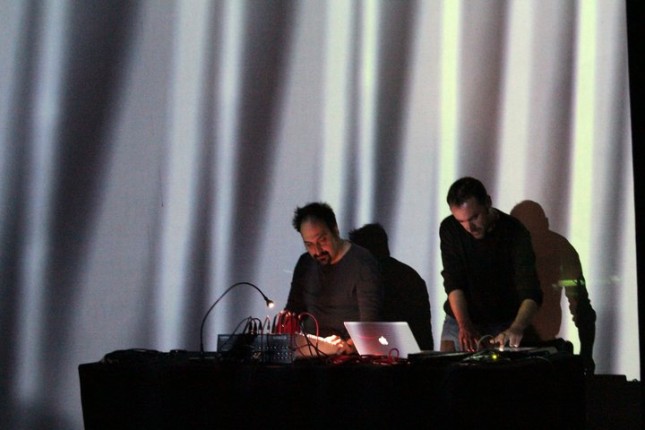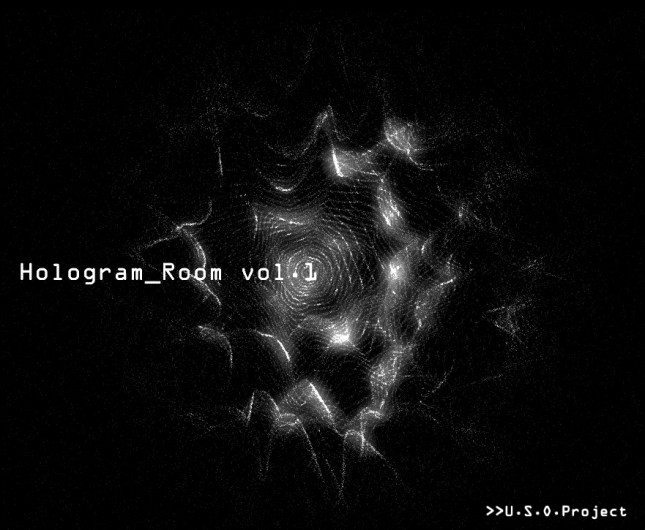
U.S.O (Unidentified Sound Object) Project is defined as a continuing evolving organism of sound. Created by Matteo Milani and Federico Placidi, two sound artists working on several fields and exploring sound in many inspiring ways. Perhaps you already know about their fantastic blog, where they share lots of great things, making the site a must for anyone interested on sound experimentation, film sound design, electronic music, sound synthesis, signal processing, etc.
In the last year, Unidentified Sound Object started a new series of libraries aimed to sound designers and composers, starting with Hologram Room, a package of a wide variety of sources suitable for all kind of contexts and designed meticulously by the two sound sculptors. Today they’ve released their second package, which includes a fantastic collection of sounds created from electro-magnetic field captures.
Electromagnetic informations are invisible and omnipresent. In every city, especially the big ones, an infinite number of electromagnetic waves is hidden: we can’t hear them, but they’re everywhere! We explored this invisible noise pollution transducing electromagnetic fields into audio signals with a telephone pickup: it acts like a radio antenna for hum and weird electromagnetic noises.
We plugged it into a SONOSAX SX-R4 recorder, moving it close to electrical devices – like a stethoscope – to locate interesting and curious sounds, just like LCD television, internet antennas, lighting systems, transformers, game consoles, tablet, electronic security systems, scanners, computer monitors and hard-drives, printers, navigation systems, fax machines…
Available at U.S.O. $30, 40 files, 48kHz/24-Bit.
[soundcloud url=”http://api.soundcloud.com/tracks/33554322″ iframe=”true” /]
Below is an interview I did with Matteo and Federico, talking a bit about this new library and the ideas behind their project.
DS: Why you became interested on releasing a sound library about electro-magnetic sources?
M&F: For this Unseen Noises (USO002) we used telephone tap coils that receive electromagnetic signals around us and convert them into audible information to discover invisible and surprising aspects of the environment in which we live in. To widen our sound palette, we explored cell phones, tablets, light systems, automated teller machines, wireless communication systems, anti-theft security devices, surveillance cameras, computers, navigation systems, wireless Internet routers, neon advertisings, public transportation networks. We just used the system of electromagnetic induction as way of amplifying musical sounds. Our efforts were focused on finding “articulated” behaviours and other musical qualities in them. Note that the files contained in “Unseen Noises” are real performances executed on different devices without editing. What you hear is a selection of several hours of recording: you’ll find those sounds in our musical productions such as InharmoniCity or installations like Empty Rooms.

DS: I wonder how’s your collaboration as a team and how is sound design and music linked in your work?
M&F: Our first meeting dates back to 2005 on the Cinema Audio Society forum. Despite the distance between our hometowns (Milan-Rome), from day one we’ve been very good friends and we never stopped producing ideas and material in various forms – under the common denominator of Unidentified Sound Object. This second sound library is a good example of multi-disciplinarity. Our experience in different domains – from post-production to composition – helped us creating musical material of various kinds. Sound editors and designers can choose whether to use the sounds contained in our collections as they are, or sculpt them further – being very rich in the frequency spectrum. It’s material which lends itself to be processed in the frequency domain in order to extract the masked harmonic components. Our work is all about detail, and our albums take a long time to make. Usually we extract from a raw material the aspects that will serve the compositional idea. In every collection there is a part of each one of us, a mixture of our different experiences.
DS: What about processing of the elements?
M&F: We processed the recordings a little, by means of decorrelation, to control only the source width and create a diffuse sound field. When decorrelating the source between two speakers, the impression is a psycho-acoustic spreading of the audio in the space between them to achieve a diffuse, broad sound image. A recording is replicated in a second channel and shifted with a variable offset (ms). Decorrelation of audio signals uses this micro-temporal delay to enrich the sonic complexity of the overall listening experience, creating timbrical colouration and combing due to constructive and destructive interference. These time intervals are indeed acting and influencing our perception of musical facts. As in “Hologram Room”, we took care of the loudness overall level: the problem we always found navigating through sound libraries of different origins, is the extreme difference in signal level between their content. Having examined the subject in loudness over the past two years, it is clear that it no longer makes sense to peak normalize the sound-files, but it is better to balance them towards a universal center of gravity. Personally I found the EBU R128 solution an efficient response. The experience of moving between sound effects and music without constantly adjusting the listening level is an approach on which we can not give up. The future is in the loudness control and the calibration of the monitor. The K-System by Bob Katz – who has the authorship of the system – is an effective solution: excellent readings are available on his website digido.com.

DS: Although you designed all the sounds included in the package Hologram Room (USO001), it doesn’t feel like a collection of designed sounds. I’d say is more like a package of layers or something like “designed raw elements”. If that’s correct… could you tell us how do you proceed on making these single elements, rather than “ready to use” sounds?
M&F: The sound sources can be extracted from field-recordings, everyday objects, acoustic instruments or materials generated through analog and/or digital synthesis. This library is born instinctively, at first in an effort to create a private archive of custom designed sound effects to work, easily available for TV works. The effort to create an appropriate catalog, has generated similar groups for various applications. What we were looking for, was a family of recombinant sounds, to be easily layered and structured in any DAW. Thanks to Kyma and the custom tools in our possession, we’ve been able to sculpt our idea in an easily and familiar environment with instant feedback, before jumping in the Pro Tools timeline. We wondered: why not provide the material extracted from our musical encounters as “raw” material, but already organized, to suggest “emotions”? Fragments of sound materials – amorphous in terms of musical discourse – are defined by David Lynch and his composer Angelo Badalamenti as firewood. The director said that “continuing to work with sound, what you do not want to become is more and more evident.” In fact, the most perceptually original ideas we had, have always determined the nature of our compositions, with or without sound processes of transformation and transfiguration. Every phenomenon, deliberately taken out of its natural context, becomes something else and is no longer reconstitutable.
DS: What were your main tools and methods for fabricating sounds for these categories? Specifically talking about Kyma, could you tell us about the advantages you find for sound design related works? I wonder if you have any thoughts regarding other “similar” alternatives, such as Max/MSP for example.
M&F: Max/MSP and Kyma are not really similar. Kyma shares more similarities with SuperCollider. The advantages are in terms of operating procedures and efficiency of programming in an object oriented environment. All the control domain functions are written in Capytalk (a real-time implementation of Smalltalk). So the fact that you can “code” functions instead of patching them is quicker and more elegant (in terms of debugging). Kyma offers a true DSP object oriented work-flow that is focused on sound design. Max is more flexible when we talk about multimedia stuff, like installations, augmented reality or cross-domain applications. There is an issue about sound quality as well. Kyma has its own “sound-print”, which we like very much.
DS: How much improvisation is involved in the process?
M&F: Improvisation or sound exploration is fundamental. Sometimes you can achieve interesting and unexpected results only running trough unknown paths. It is time consuming – of course, but very often you find undiscovered territories only if you lose yourself inside them. Experience plays also a great role. It is not about what to do, but what to not do. It’s a negative approach; don’t do this or that, because you already know what it will sound like. It is a series of no, and no, an so on until you find what is left, which is very often quite challenging. Most appropriate for our work of art is the process of designing our tools and to study their “aural” behaviours based on what we would like to accomplish. Then the feedback approach comes into play. You do something and then you hear the output, very often predictable, then you inject some amount of “randomness” into it and things start to sound more exciting. A very stimulating approach is what we call “exploring the phase space”. When you define an instrument, that instrument can achieve specific discrete configuration states. We obtain this by using presets, and presets of presets. Then we move inside this discrete space adding just a little bit of randomness around each predefined states. So you explore in a non-linear way the behaviour of the system and its internal dynamics.
DS: How regularly are you thinking to release these libraries? What could we expect in these series?
M&F: Like every one of our free initiatives, there is no precise schedule for the release of future libraries; we would like to produce at least a couple of packages a year, derived from timbrical explorations of ongoing projects. We’ve quietly started working on a new collection: our job is to always deal with something new, to find sound objects for aesthetic consideration on their own terms. We’re just kind of scratching at the surface of that, we’ll see where it ends up. And in the pipeline there’s a new upcoming “untitled” album, to be released soon. In parallel, we recorded a considerable amount of material for a mobile interactive album that will be released very soon, a pure sensory experience.
[vimeo]http://vimeo.com/37606664[/vimeo]
Wow, great interview!